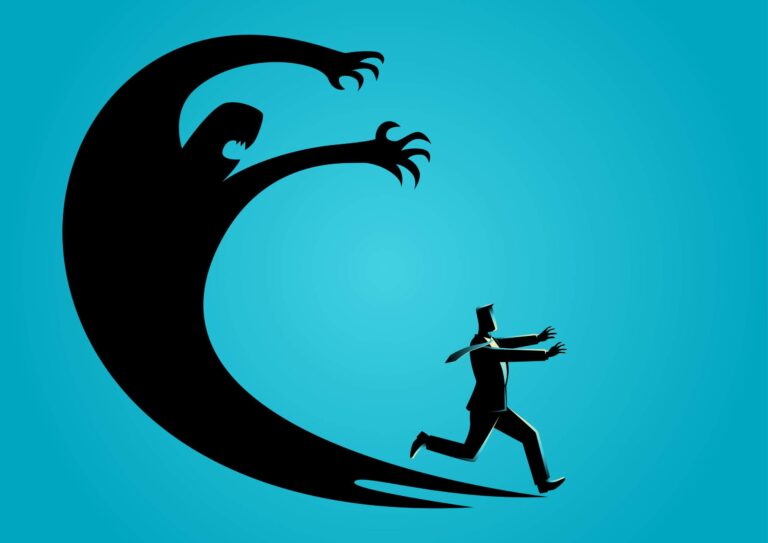“`html
I find myself on stage facing a crowd of 150, the spotlight glaring into my eyes, gripping the microphone tightly. All eyes are focused on me, filled with anticipation. I am here to share a story. For many, being in this position would be terrifying. Stage fright can make your heart race, your mouth dry, and your body tremble. But not me. I feel at home here. Instead, my greatest fear lies waiting for me at home, which is exactly what I’m here to discuss.
“For most of my life, I have dealt with a nagging, overwhelming fear of being killed in my sleep,” I reveal to the audience. They respond with laughter. It’s not due to insensitivity—I’m sharing it humorously. That’s my way of coping. I recount the phantoms that lurk in my restless imagination: Bigfoot, vampires, Adolf Hitler, the Loch Ness Monster, and even Jesus—complete with his thorny crown and blood—my childhood terrors. Then there are the real-life dangers: the Boston Strangler, Ted Bundy, the Zodiac Killer—the monsters of true crime that dominated my teenage reading. Fear has always been by my side.
This isn’t entirely unexpected. Growing up as a girl in the 1970s and ’80s in Southern Ontario, I was glued to the news from a young age, reading daily papers and magazines like Family Circle and Women’s Day, which were filled with stories of violence against women and girls. Kids my age vanished from the hallways of their buildings or were last seen hopping on the subway to see a movie with friends. Women like my mother were stalked in parking lots, lured into vans when trying to help someone in distress, and then were never seen again. I learned to walk with my keys clenched between my fingers. Conflicting advice bombarded me: fight back or give in? With long hair, I learned to tuck it into my coat to avoid being grabbed from behind.
Fear has always been a part of my life.
Some of this fear was merely caution—self-preservation. It was the atmosphere I grew up in, where misogyny and violence against women were woven into society—from news headlines to the mysteries my mother read and the shows we watched. Yet, this fear also flipped a switch within me that was hard to turn off. I became hyper-aware.
The Nervous Wreck
Looking back, I realize I was grappling with anxiety from a very young age, though we didn’t label it as such back then. We called it don’t be such a wuss, she’s scared of her shadow, and that’s absurd. To be fair, much of what I feared was quite silly. Parked cars (they might suddenly drive away!), our furnace room (possibly the hideout of Sasquatch), a picture of a statue I once saw (felt as if it was staring right at me). My imagination was both my ally and my tormentor; I felt powerless against its endless creativity.
However, I learned how to make light of my fears. I turned my experiences into humorous tales that I shared repeatedly. I realized, perhaps too late, that not everyone is paralyzed by nighttime fears. Once I recognized my anxiety as unusual, I dove into every childhood incident that reinforced my terror. I remember one night at age seven or eight when I got up to go to the bathroom and, half-asleep, bumped into my dad, who was checking on us before he and my mom went to bed. It scared me senseless.
There was another night when, at 17, I stayed up by myself reading about the Zodiac Killer. I was so frightened to sleep that I kept reading, even though the story ended ambiguously—he was still out there! What if he was lurking in my quiet neighborhood in Mississauga? As I lay in bed, my heart raced at every creak and whisper. I imagined someone was stealthily entering my home. I fought with my mind, chastising myself, but fear clung to me.
On stage, the audience enjoyed these anecdotes, laughing and gasping at the right moments. Recently, however, I began to question if my fears were as amusing as I believed. After sharing my story with two friends, I noticed their worried expressions. “It’s all good!” I reassured them. “It’s funny!” Yet their concern lingered, making me wonder if perhaps my fear was more than just funny.
After the show, women approached me outside the venue to express how much they identified with my story. They shared that they too feared being murdered in their own beds and were grateful to know they weren’t alone in this anxiety. It felt rewarding, and I walked home buoyed by the sense of connection. That night, I slept peacefully for the first time in ages, despite my spouse being away and me being alone in a large house.
The very next night, however, was a different story.
The Nature of Fear
The fear crept in early that evening, even before it was fully dark. Working alone at home, I felt no fear throughout the day. I taught creative writing as night fell. One of my student’s parents had attended my show the previous evening, and the dad made a strange remark during pickup. That switched my brain to High Alert. After the parents and kids left, I noticed the fairy lights I keep on the mantel had been turned on, although I hadn’t done it myself.
If this were a scene in a thriller, tense music would play in the background. My fear tightened its grip and wouldn’t let go.
Lying in bed that night, I reminded myself I had checked the locks. Yet my mind conjured a patient intruder lying in wait for me. I felt paralyzed by fear. I held my breath. Every little noise felt amplified. The stillness felt unsettling, as if it were simply a precursor to chaos.
As I drifted in and out of consciousness, I would wake with my heart racing, questioning, “Was that a sound? What was that noise?” The front door creaking open? The back? Someone slithering through the kitchen window? Is there someone lurking in my room? My eyes strained to decipher the shadows surrounding me.
This was an all-too-familiar cycle, my nightly performance. I tried reasoning with myself, Don’t be absurd.
What would life look like without this ever-present fear?
This is the height of egotism. You really think you’re so appealing that a murderer would wait for you to finish watching Netflix and wind down? It’s ludicrous. Illogical. The truth is, most people don’t get murdered in their beds. Time to sleep already!
Yet, my stern internal dialogue did little to help me find restful sleep. Most nights, I would eventually drift into uneasy slumber. However, this night was different. This night,
“““html
The fear wouldn’t release its grip on me. So, I did something I had never tried before.
I switched on the light. My heart was racing with anxiety and embarrassment as I pushed a heavy piece of furniture to block our bedroom door, then crawled back into bed.
I scrolled through my phone. I picked up a book. Nothing worked; I felt miserable, like I had let myself down. I remained wide awake, gripped by fear.
Finding Comfort
I tried not to make Debbie’s office feel like a stage for my night terrors, but my tales have been recounted so often that I fell into storytelling mode. “I’m pretty certain the sounds I hear are coming from me,” I told her. “Snoring, grinding my teeth. I wake up, expecting the sound to return, but since I caused it, it never does, leaving me anxious and alert.”
“I wear glasses too,” I mentioned, which means I can’t see clearly at night.
“So, you’re exposed,” she responded. I agreed.
“I don’t know how to fix that,” I said.
“It’s not something to fix,” she replied.
Oh.
Then she asked: “Tell me about the murder.” I said: “Oh, the murder isn’t important.”
My therapist is quite composed. She nodded. “Then what are you afraid of?”
I contemplated all the possible answers. “Terror. I’m scared of being terrorized.”
She nodded again, her expression gentle and encouraging.
“Oh,” I said, as a thought began to form. “It’s me.”
I had been so afraid of terror that when I finally recognized it, it felt like dawn breaking. “I am terrorizing myself,” I proclaimed. “I’m doing it to myself.”
Debbie suggested I find a comforting object to reach for at night when The Fear began to creep in. It struck me as a revolutionary idea that comfort was an option. “What have you been reaching for?” she asked.
“Mostly reason,” I replied, “and strict self-talk.”
“And how has that worked out?” “Well, here I am,” I said.
Vulnerability and Me
That afternoon, my spouse left for a two-week tour. Once again, I was home alone, fully aware of my vulnerability, trying to see it as a strength rather than a flaw. (I told Debbie that most people don’t get murdered in their beds, to which she responded, some do, which was oddly comforting, helping me accept my fear while recognizing its role in keeping me safe instead of shaming me for it.) When I returned home from errands, I instinctively said aloud as I entered, “Ah, my cozy home.” This helped me feel safe rather than immediately worrying that a murderer was hiding in the basement. Later, as I prepared for bed, I pulled back the covers and murmured, “Ah, my cozy bed.”
But after I fell asleep, I woke up again, startled by a noise nearby. It was likely just my teeth clenching together, I thought, but I could already feel the icy fingers of fear creeping up my back. I knew what was coming next—my imagination would run wild, and I’d be in for a tumultuous night. So I took a deep breath. I paused. You have a choice here, I reminded myself. You can either choose terror or choose something else. I took another breath, turned to my side, and gently pressed my hand against my heart. Out loud, I said, “You deserve peaceful sleep and sweet dreams.” Then, I closed my eyes and experienced both.
When I recount this story now, I still share it with humor—it’s my preferred way. But I also reflect with awe on the transformative power of self-compassion, which has become my ally instead of fear during the night.
The inclusion of self-compassion in my nighttime ritual has also spilled over into my daytime life. Although my first instinct is still to be logical and stern with myself, being kind to myself during night terrors has allowed me to reassess how I treat myself during the day. While the shift toward self-kindness takes time, when I remember the choice, I select kindness every time—it enhances both my days and my nights.
Befriending Fear: Working with Worry and Anxiety
The fear-response is a powerful emotional and physiological reaction that can be triggered by more than just an imminent physical threat. In this excerpt from his book *The Mindfulness Solution*, Ronald D. Siegel, PsyD, delves into the human reaction to fear and demonstrates how mindfulness can help manage it.
Read More
What Are You Afraid Of?
Public speaking is one of the most common fears people have. Check out this mindfulness practice designed to help control those butterflies in your stomach—without the need to visualize the audience in their underwear. [Podcast]
Read More
“`


